Five scientists analyzed the article and estimate its overall scientific credibility to be 'very low'. more about the credibility rating
A majority of reviewers tagged the article as: Biased, Flawed reasoning, Inaccurate, Misleading.
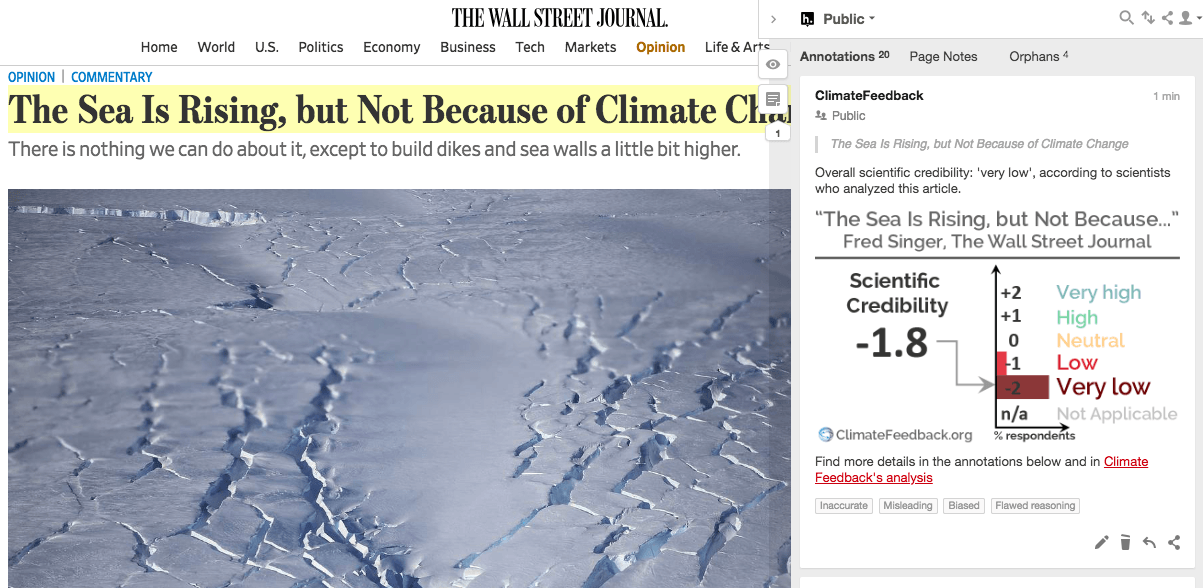
SCIENTISTS’ FEEDBACK
SUMMARY
This commentary published by The Wall Street Journal, written by Fred Singer, claims that warming (and therefore greenhouse gas emissions) has no effect on global sea level rise. Although Singer concedes the physical fact that water expands as its temperature increases, he claims that this process must be offset by growth of Antarctic ice sheets.
Scientists who reviewed this opinion piece explained that it is contradicted by a wealth of data and research. Singer bases his conclusion entirely on a cherry-picked comparison of sea level rise 1915-1945 and a single study published in 1990, claiming a lack of accelerating sea level rise despite continued warming. But in fact, modern research utilizing all available data clearly indicates that sea level rise has accelerated, and is unambiguously the result of human-caused global warming.
Since the 1990s for example, satellites have measured an acceleration in the rate of global sea level rise:
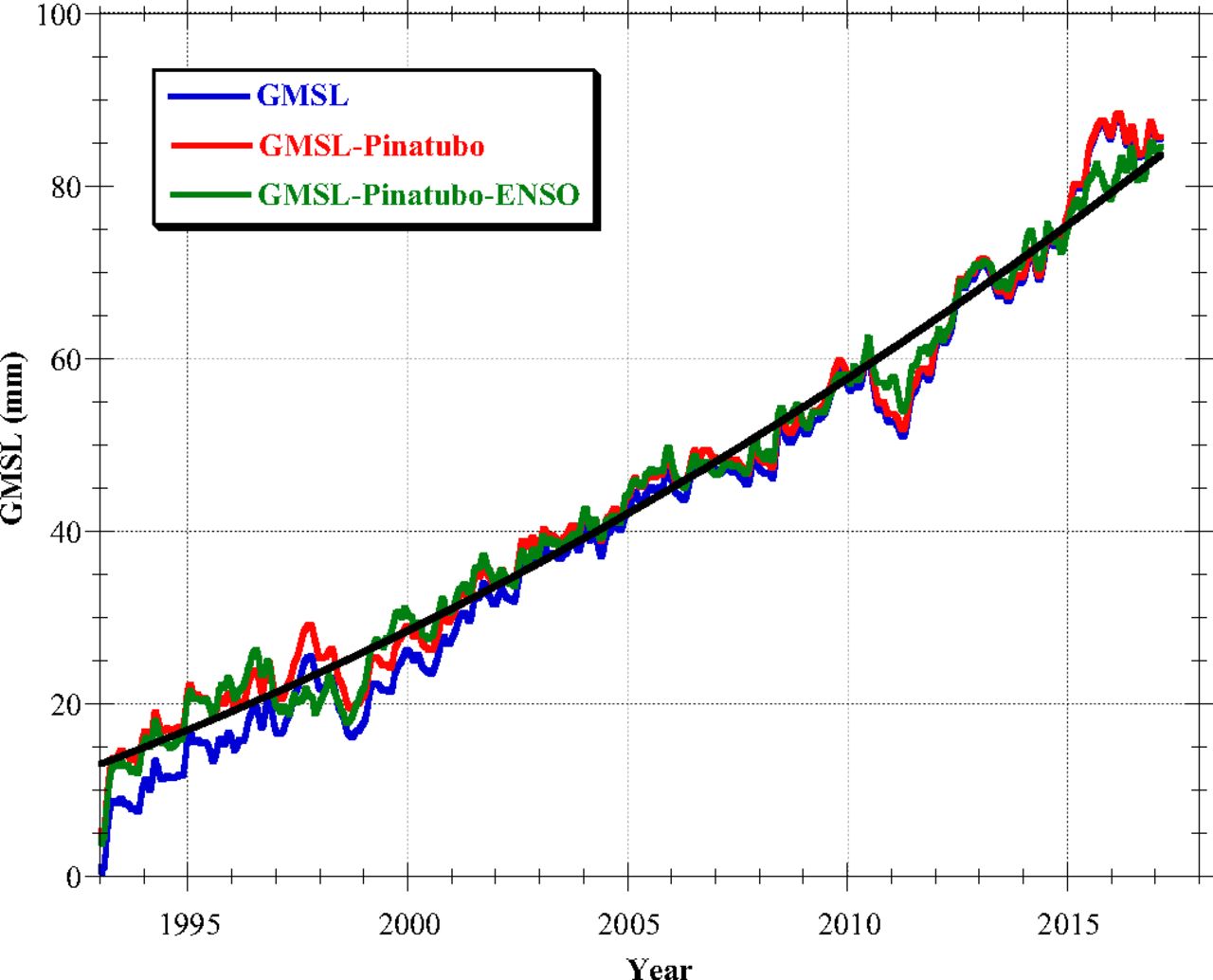
Figure – Global mean sea level (blue), after removing an estimate for the impacts of the eruption of Mount Pinatubo (red), and after also removing the influence of El Niño (green), fit with a quadratic (black). From Nerem et al. (2018)
See all the scientists’ annotations in context
REVIEWERS’ OVERALL FEEDBACK
These comments are the overall opinion of scientists on the article, they are substantiated by their knowledge in the field and by the content of the analysis in the annotations on the article.
Chris Roberts, Research Scientist, ECMWF/Met Office:
This article severely misrepresents the scientific understanding of the processes responsible for observed changes in global sea level. Understanding and attributing the causes of changes in global sea level is an area of active research and there are genuine uncertainties, but there is a clear consensus on the important roles for ocean thermal expansion and addition of mass to the oceans from melting glaciers and ice caps during recent decades. For example, the following paper by Church et al. (2008)* summarizes the independent lines of evidence for changes in sea level from satellite altimeter and tide gauge measurements and how these changes can be explained by a combination of thermal expansion and exchange of mass (either liquid water or ice) between the oceans and continents:
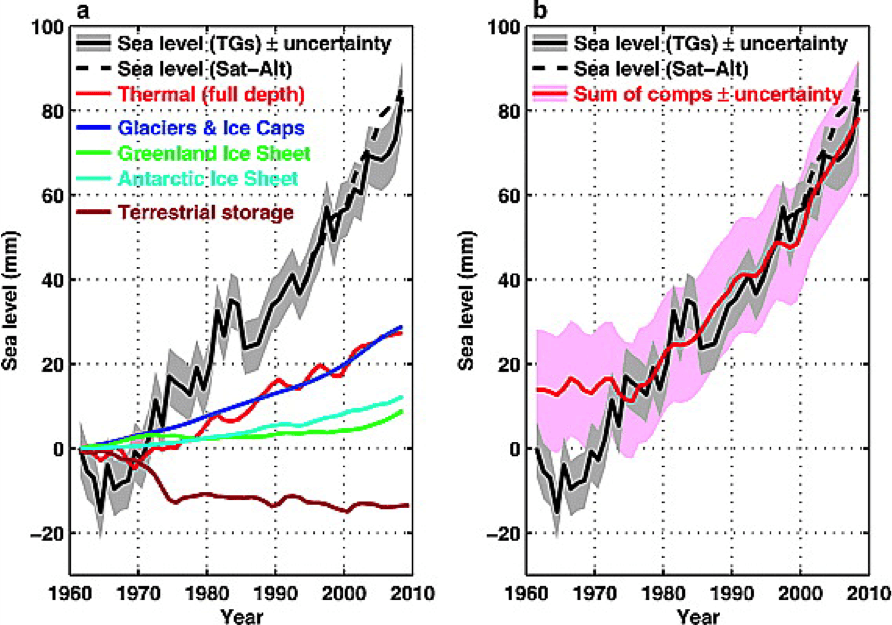
Figure – Global sea‐level budget from 1961 to 2008. (left) The observed sea level using coastal and island tide gauges (solid black line with grey shading indicating the estimated uncertainty) and using satellite altimeter data (dashed black line) with thermal expansion and glaciers melting components; terrestrial storage (e.g. dams) partially offsets other contributions to sea‐level rise. (right) The observed sea level and the sum of components.
- Church et al (2011) Revisiting the Earth’s sea‐level and energy budgets from 1961 to 2008, Geophysical Research Letters
Stefan Rahmstorf, Professor, Potsdam University:
The article has almost nothing to do with the modern state of sea-level science. The author tries to call into question that global warming causes sea-level rise, and does so by cherry-picking a short segment of data from 1915-1945, a time when data quality is poor and the warming signal small—a bizarre approach that could never pass scientific peer review and is apparently aimed at misleading a lay audience.
Keven Roy, Research Fellow, Nanyang Technological University:
This article is misleading, and presents inaccurate statements about global mean sea level rise.
Benjamin Horton, Professor, Earth Observatory of Singapore:
If this were an essay in one of my undergraduate classes, he would fail.
Notes:
[1] See the rating guidelines used for article evaluations.
[2] Each evaluation is independent. Scientists’ comments are all published at the same time.
KEY TAKE-AWAYS
The statements quoted below are from Fred Singer; comments and replies are from the reviewers.
The noted oceanographer Walter Munk referred to sea-level rise as an “enigma”
Benjamin Horton, Professor, Earth Observatory of Singapore:
It is interesting that this opinion piece starts off with “Munk’s enigma”. This was introduced by famed oceanographer Walter Munk in a 2002 paper published in Proceedings of the National Academy of Sciences. The enigma refers to a key discrepancy between the amount of sea-level rise believed to have occurred during the 20th century and the effects it should have produced on the planet — specifically, on the Earth’s rotation. So in addition to all the devastating and obvious effects sea-level rise will produce on the planet, such as flooding and erosion, sea-level rise also has the more subtle, but nonetheless mind-boggling ability to alter the way the Earth rotates on its axis. In a recent paper, Jerry Mitrovica and an interdisciplinary team of colleagues claim to have resolved the enigma. They reinforce the awe-inspiring power of climate change to produce global-scale effects, changing the planet’s very rotation. I don’t understand the relevance of citing Walter Munk to support Singer’s argument.
I chose to assess the sea-level trend from 1915-45
Benjamin Horton, Professor, Earth Observatory of Singapore:
This is a blatant case of cherry picking to confirm a Singer’s position while ignoring all other instrumental sea level data that may contradict that position. This fallacy is a major problem in public debate.
Stefan Rahmstorf, Professor, Potsdam University:
It is rather ironic that the author first complains about “poor data” and then goes on to cherry-pick a time of particularly poor data that includes the World War 2 period. Even the temperature data from this period are questionable; the sea surface temperature data show a strong warm peak at the end of WW2 (the basis of his claim of 0.5 °C warming) which is probably a data collection artefact, given that no such warming is seen in the data collected at the global network of weather stations on land. Also, in the peer-reviewed literature it has been shown that minor inaccuracies in sea-level data by just a few millimeters can lead to spurious fluctuations of sea level trends when too-short time intervals are considered*.
- Rahmstorf et al (2011) Testing the robustness of semi-empirical sea level projections, Climate Dynamics
I note particularly that sea-level rise is not affected by the warming; it continues at the same rate, 1.8 millimeters a year, according to a 1990 review by Andrew S. Trupin and John Wahr.
Stefan Rahmstorf, Professor, Potsdam University:
This claim is against the basic laws of physics—warming causes thermal expansion of sea water and thereby sea-level rise, full stop. This is true regardless of whether this effect can be detected in a cherry-picked short time interval with poor data quality.
Keven Roy, Research Fellow, Nanyang Technological University:
This is very misleading. Why is the author using a review dating from 1990, when there have been many publications over the past 28 years that show a much higher rate of Global Mean Sea Level (GMSL) rise over the last few decades?
For instance, Hay et al* have looked at tide gauge records since the beginning of the 20th century and found that the rate of GMSL rise was 1.2 +/- 0.2 mm/yr over the 1901-1990 period, but 3.0 +/- 0.7 mm/yr over the 1993-2010 period (this period corresponds to the time for which we also have satellite altimetry measurements, which are consistent with this rate).
The author also talks about an “accelerating rate” of sea-level rise later in his article, which contradicts his own statement.
- Hay et al (2015) Probabilistic reanalysis of twentieth-century sea-level rise, Nature
Ernst Schrama, Associate Professor, Delft University of Technology:The trend has been measured by a network of tidal gauges, many of which have been collecting data for over a century.
There are more indicators than a network of tide gauges. The mass loss of West Antarctica and Greenland is observed by satellite gravimetry, and it shows an acceleration in the mass loss*.
- Seo et al (2015) Surface mass balance contributions to acceleration of Antarctic ice mass loss during 2003–2013, Journal of Geophysical Research: Solid Earth
- Velicogna et al (2014) Regional acceleration in ice mass loss from Greenland and Antarctica using GRACE time‐variable gravity data, Geophysical Research Letters
[read “New York Times series accurately describes research on Antarctic ice sheets and sea level rise, but highlights uncertain studies” for further details]
But efforts to determine what causes seas to rise are marred by poor data and disagreements about methodology.
Stefan Rahmstorf, Professor, Potsdam University:
This is not correct. First of all, the oceans are warming and warming water expands—a basic law of physics. Second, mountain glaciers and ice sheets are melting due to global warming, adding water to the ocean—an observational fact. Third, independent estimates of these contributions to sea-level rise match the actually observed sea level rise.
Ernst Schrama, Associate Professor, Delft University of Technology:
I think this is a misinterpretation of what is currently known about sea level rise where we know that roughly 50% comes from glaciers’ mass loss, and the other 50% comes from volume expansion because of heat. There are multiple independent observation systems that confirm the current knowledge.
as continents rise after the overlying ice has melted
Keven Roy, Research Fellow, Nanyang Technological University:
Glacial Isostatic Adjustment (GIA) also causes subsidence of the solid Earth surface in the regions located outside the margins of the former ice sheets (for instance, along the U.S. East coast, where GIA-related subsidence is exacerbating the effects of global mean sea level rise).
contrary to the general wisdom—that the temperature of sea water has no direct effect on sea-level rise
Stefan Rahmstorf, Professor, Potsdam University:
This is not just against conventional wisdom but also against the laws of physics.
I conclude that it must be ice accumulation, through evaporation of ocean water, and subsequent precipitation turning into ice. Evidence suggests that accumulation of ice on the Antarctic continent has been offsetting the steric effect for at least several centuries.
Ernst Schrama, Associate Professor, Delft University of Technology:
There is only one place on East Antarctica, called Dronning Maud land, where there is some growth of the Antarctica Ice Sheet, and it does not compensate for the loss that we observe with satellite gravimetry on other parts of Antarctica.
Stefan Rahmstorf, Professor, Potsdam University:
Satellite data show that mountain glaciers as well as the large ice sheets on Greenland and Antarctica are all losing ice mass in recent decades, at an accelerating rate. Check out NASA’s data:
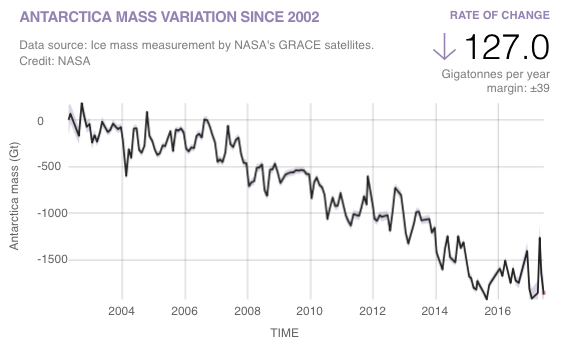
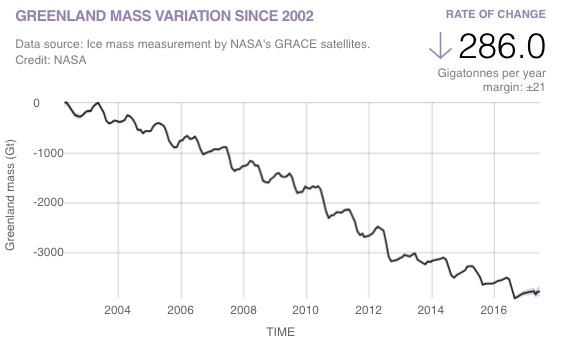
Figure – GRACE Satellite measurements of ice mass variations in Antarctica and Greenland since 2003.
It is difficult to explain why evaporation of seawater produces approximately 100% cancellation of expansion.
Stefan Rahmstorf, Professor, Potsdam University:
It would indeed be difficult to explain. But it just doesn’t, otherwise sea level would not be rising.
Currently, sea-level rise does not seem to depend on ocean temperature, and certainly not on CO2.
Stefan Rahmstorf, Professor, Potsdam University:
There is a clear relationship between the accelerating rate of sea-level rise and the increasing global temperature, which is shown in this post (e.g. in Figure 3).
But there is also good data showing sea levels are in fact rising at an accelerating rate.
Stefan Rahmstorf, Professor, Potsdam University:
Indeed.
1 to 2 millimeters a year
Keven Roy, Research Fellow, Nanyang Technological University:
This is not the current rate of observed global mean sea level rise. It is rather around 3.0 mm/yr*.
- Dieng et al (2017) New estimate of the current rate of sea level rise from a sea level budget approach, Geophysical Research Letters
All this, because it is much warmer now than 12,000 years ago, at the end of the most recent glaciation.
Stefan Rahmstorf, Professor, Potsdam University:
Data from sediment cores from around the world show that none of the preceding 20 Centuries show even remotely as much sea-level rise as the 20th Century. Think about it: over the past decades, sea levels have been rising at a rate of 3 cm per decade, as satellites show. If this had been going on for millennia, then just 1,000 years ago, in the Middle Ages, sea levels would have been 3 meters lower than today, and in Roman times 6 meters. That is definitely not the case as many remaining coastal structures from earlier times show (e.g. Roman fish ponds that were connected to the sea). The entire article is nonsensical.
By 2100 the seas will rise another 6 inches or so—a far cry from Al Gore’s alarming numbers
Benjamin Horton, Professor, Earth Observatory of Singapore:
They are not Al Gore’s numbers! These are the sea-level rise projections from the scientific community who go through the peer review process. That is, the evaluation of the sea-level projections by one or more people of similar competence to the producers of the work (peers). It constitutes a form of self-regulation by qualified members of a profession within the relevant field. Peer review methods are employed to maintain standards of quality, improve performance, and provide credibility of sea level projections.
[read “Sea level could rise by as much as 1 or 2 meters (3.3-6.6 feet) by the year 2100” for further details]
Mr. Singer is a professor emeritus of environmental science at the University of Virginia. He founded the Science and Environmental Policy Project and the Nongovernmental International Panel on Climate Change.
Ernst Schrama, Associate Professor, Delft University of Technology:
Fred Singer has a long history or raising false and misleading arguments that deny climate change. It is difficult to understand that the Wall Street Journal provides him a platform to display his statements.
Please read the last assessment report of the IPCC, it provides a good description of the scientific knowledge with regard to sea level change and the relation to climate change.

